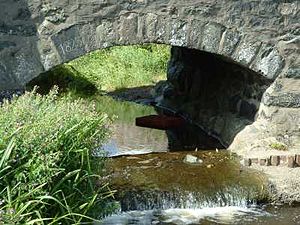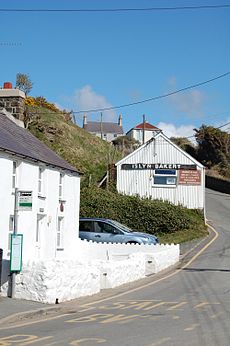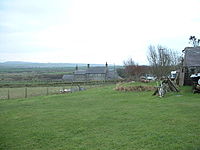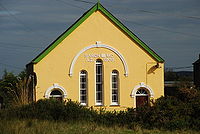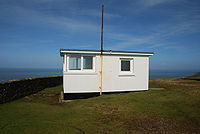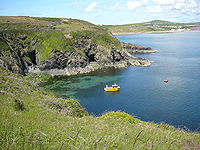Aberdaron
| Aberdaron | |
| Caernarfonshire | |
|---|---|
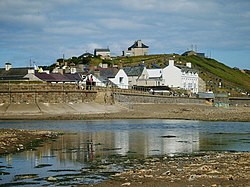 Aberdaron from the beach | |
| Location | |
| Grid reference: | SH1726 |
| Location: | 52°48’29"N, 4°42’36"W |
| Data | |
| Population: | 1,019 (2001) |
| Post town: | Pwllheli |
| Postcode: | LL53 |
| Dialling code: | 01758 |
| Local Government | |
| Council: | Gwynedd |
| Parliamentary constituency: |
Dwyfor Meirionnydd |
Aberdaron is a village at the western tip of the Llŷn Peninsula in Caernarfonshire. It lies 15 miles west of Pwllheli and 33 miles southwest of Caernarfon, and had a population of 1,019 in 2001. Aberdaron is sometimes referred to as the "Land's End of Wales" (Welsh: Pendraw'r Byd).
The parish includes Bardsey Island, the coastal area around Porthor, and the villages of Anelog, Llanfaelrhys, Penycaerau, Rhoshirwaun, Rhydlios, Uwchmynydd and Rhiw.
The village was the last rest stop for pilgrims heading to Bardsey Island, the legendary "island of 20,000 saints". In the 18th and 19th centuries it developed as a shipbuilding centre and port. The mining and quarrying industries became major employers, and limestone, lead, jasper and manganese were exported. After the Second World War the mining industry collapsed, and Aberdaron gradually developed into a popular holiday resort.[1] The beach was awarded a Seaside Award in 2008.[2]
Contents
Name of the village
Aberdaron means "Mouth of the Oak River", a reference to the River Daron which flows into Aberdaron Bay in the village.[3]
History
Evidence from one of the most important archaeological sites in Wales, the Iron Age hillfort at Castell Odo, on Mynydd Ystum, suggests that the area around Aberdaron was colonised early, as a wave of Iron-age settlers explored the Irish Sea, probably around the 4th century BC. The construction was wholly defensive, but in later phases defence appears to have been less important, and in the last phase the fort's ramparts were deliberately flattened. Ptolemy knew this coast and calls Llŷn "Ganganorum Promontorium" (“Peninsula of the Gangani”), which suggests what might have been the name of the local tribe in the Iron Age.
In 1094, Gruffydd ap Cynan, the exiled King of Gwynedd, sought refuge in the church at Aberdaron while expelled from his throne, and he escaped in the monastic community's boat to Ireland.[4] He regained his territories in 1101. In 1115, Gruffydd ap Rhys, the exiled prince of Deheubarth, took refuge at Aberdaron to escape capture by the King of Gwynedd, who was intending to hand Gruffydd over to King Henry I of England The King of Gwynedd ordered that the fugitive prince be dragged from the church by force, but his soldiers were beaten back by the local clergy allowing Gruffydd to escape under cover of night and fleed south to Ystrad Tywi.[5]
After his conquest of Gwynedd, in 1284 King Edward I visited Aberdaron on his way to Bardsey Abbey.[6]
After the Civil War, when the Parliamentarians under Oliver Cromwell introduced a strongly Protestant regime, Roman Catholicism remained the dominant religion in the area. Romanists were often considered to be traitors and efforts were made to eradicate the religion. The persecution even extended to Aberdaron, and in 1657, Gwen Griffiths of Y Rhiw was summoned to the Quarter Sessions accused of being a papist.
Agricultural improvement and the Industrial Revolution came to Aberdaron in the 19th century. The Inclosure (Consolidation) Act 1801 was intended to make it easier for landlords to enclose and improve common land, introduce increased efficiency, bring more land under the plough, and reduce the high prices of agricultural output. Rhoshirwaun Common, following strong opposition, was enclosed in 1814; while the process was not completed in Aberdaron, Llanfaelrhys and Y Rhiw until 1861.[7] On the industrial front, mining developed as a major source of employment, especially at Y Rhiw, where manganese was discovered in 1827.[8]
During the Second World War, Y Rhiw played a vital role in preparations for the Normandy Landings. A team of electronic engineers set up an experimental ultra high frequency radio station, from where they were able to make a direct link to stations in Fishguard and Llandudno. The system employed a frequency that the German forces were unable to either monitor or jam, and was used in the 1944 landings.[9]
Landscape
Aberdaron stands on the shore of Aberdaron Bay in a small valley at the confluence of the River Daron and the River Cyll-y-Felin, between the headlands of Uwchmynydd to the west, and Trwyn y Penrhyn to the east.[4] At the mouth of the bay stand two islands, Ynys Gwylan-Fawr and Ynys Gwylan-Fach, which together are known as the Seagull Islands.[1] Llŷn is a marine eroded platform, an extension of the Snowdonia massif, with a complex geology including Precambrian rocks.[10] The coastline is rocky, with crags, screes and low cliffs; heather covered hills are separated by valleys occupied by pastures.[11]
To the east, Mynydd Rhiw, Mynydd y Graig and Mynydd Penarfynydd form a 3-mile long series of hog-back ridges of igneous rock that reaches the sea at Trwyn Talfarach. Above 800 feet the ridges are topped by hard gabbro. At its northern end Mynydd Rhiw rises to 1000 feet, the outcrop of Curlew's Crag looming above the village of Rhiw. Mynydd Penarfynydd is one of the best exposures of intrusive, layered, igneous rock in the British Isles.[8]
East of Y Rhiw is an extensive low-lying plateau between 65 feet and 100 feet above sea level.[12] The coastal rock is softer here, and the sea has been free to erode the rock and boulder clay to form sand, resulting in the spacious beach of Porth Neigwl ("Hell's Mouth").
West of Aberdaron, four peaks rise above the rocky shoreline at Uwchmynydd. Mynydd Anelog stands 620 feet high, Mynydd Mawr at 490 feet, Mynydd y Gwyddel rises to 295 feet and Mynydd Bychestyn is 330 feet above sea level.[13]
The coast around Aberdaron has been the scene of many shipwrecks. In 1822, the Bardsey Island lighthouse tender was wrecked, with the loss of six lives; and in 1752, the schooner John the Baptist, carrying a cargo of oats from Wexford to Liverpool, was wrecked on the beach at Aberdaron.[14] The sailing ship Newry, with 400 passengers bound from Warrenpoint to Quebec, was wrecked at Porth Orion in 1880. The crew abandoned the passengers, leaving just the captain, ship's mate and one sailor, assisted by three local men, to lead 375 men, women and children to safety.[15] A great storm swept the country on 26 October 1859 and many ships were lost: nine were wrecked at Porthor, seven of them with complete loss of life.[16] On the south coast, vessels were often driven ashore at Porth Neigwl by a combination of south westerly gales and treacherous offshore currents.[17] The Transit was lost in 1839, the Arfestone the following year, and the Henry Catherine in 1866.[16] The bay earned its English title, "Hell's Mouth", from its reputation for wrecks during the days of the sailing ship.[17]
Protected coast
The coastal waters are part of Pen Llŷn a'r Sarnau Special Area of Conservation, one of the largest marine designated sites in the United Kingdom.[18] The coast itself forms part of the Aberdaron Coast and Bardsey Island Special Protection Area,[11] and was designated a Heritage Coast in 1974.[19] In 1956 the area was included in Llŷn Area of Outstanding Natural Beauty.[10][20] Conservation Areas have been created in Aberdaron, Bardsey Island and Y Rhiw;[19] and the area has been designated a Landscape of Historic Interest.[21]
Economy
Sheep have been raised on Llŷn for over a thousand years, and Aberdaron has exported wool for many years. The main produce locally was felt, produced by soaking the cloth in water and beating it with large wooden paddles until the wool formed a thick mat which could be flattened, dried and cut into lengths.[22] There were two fulling mills on the Afon Daron, in addition to three corn mills]],[4] and lichen was gathered around Rhiw, from which a grey dye was extracted.[22] Arable crops consisted mainly of wheat, barley, oats and potatoes.[5] The field boundaries date back several centuries and are marked by walls, cloddiau and hedgerows; important habitats for a variety of wildlife.[23]
Wrecking and smuggling supplemented local incomes. In 1743 John Roberts and Huw Bedward from Y Rhiw were found guilty of the murder of two shipwrecked sailors on the beach at Porth Neigwl on 6 January 1742, and hanged; Jonathan Morgan had been killed by a knife thrust into the nape of his neck, and Edward Halesham, described as a boy, had been choked to death.[24] A ship claimed to be from France unloaded illicit tea and brandy at Aberdaron in 1767, and attempted to sell its cargo to the locals;[14] a Revenue cutter discovered salt being smuggled at Porth Cadlan in 1809; and a schooner on route from Guernsey to Scotland was reported to have offloaded lace, tea, brandy and gin at Y Rhiw in 1824.[25]
During the 19th century good quality limestone and a small amount of lead ore were quarried in the village. Jasper was mined at Carreg;[26] granite was quarried at Porth y Pistyll;[27] and there was a brickworks at Porth Neigwl.[28]
The main source of income, however, was herring fishing.[4] A regular shipping service was operated to Liverpool, exporting pigs, poultry and eggs; the vessels returned laden with coal for the neighbourhood.[5] Limestone was also imported and offloaded into the water at high tide, then collected from the beach when the tide went out. Lime was needed to reduce the acidity of the local soil, and lime kilns were built on the beaches at Porthor, Porth Orion, Porth Meudwy, Aberdaron and Y Rhiw to convert the limestone to quicklime.[29] There was shipbuilding at Porth Neigwl,[30] where the last ship, a sloop named the Ebenezer, was built in 1841;[31] and at Porthor, which came to an end with the building of a schooner, the Sarah, in 1842. Aberdaron's last ship, the sloop Victory, had been built in 1792,[32] and the last ship to come out of Porth Ysgo had been another sloop, the Grace, in 1778.[33]
The outbreak of the First World War resulted in a great demand for manganese as a strengthening agent for steel. Ore had been discovered at Y Rhiw in 1827, and the industry became a substantial employer in the village;[8] over 113,000 tons of ore were extracted between 1840 and 1945, and in 1906 the industry employed 200 people.[34]
Tourism began to develop after 1918. The first tourist guide to the village was published in 1910 and extolled the virtues of "the salubrious sea and mountain breezes";[35] in addition to the two hotels in the village, local farmhouses took in visitors, which provided an extra source of income.[36]
Sights about the village
Aberdaron
Two stone bridges, Pont Fawr and Pont Fach, built in 1823, cross the Afon Daron and Afon Cyll y Felin in the centre of Aberdaron. Beyond the bridges the road opens up to create a small market square.[4] The Old Post Office was designed by Portmerion architect, Clough Williams-Ellis.
Y Gegin Fawr (“The Big Kitchen”) was built in the 13th century as a communal kitchen where pilgrims could claim a meal on their way to Bardsey Island.[37] Aberdaron was the last place on the route for rest and refreshment and pilgrims often had to wait weeks in the village for a chance to cross the treacherous waters of Bardsey Sound.
Next to the car park is a field, Cae y Grogbren (“Gallows Field”), near which is a large red rock. In the Middle Ages, the abbot from the monastery on Bardsey Island visited the rock to dispense justice to local criminals; if they were found guilty, the wrongdoer would be hanged and thrown into Pwll Ddiwaelod (“The Bottomless Pool”). The pool is a kettle lake, formed at the end of the Ice Age, when blocks of ice were trapped underground and melted to form round, deep pools.[38]
Above the village, on the Afon Daron, stands Bodwrdda, an early 16th-century stone-built house, which had a fulling mill adjacent; two large brick-built wings were added later, giving an imposing three-storey facade containing with 17th century windows. To the south, Penrhyn Mawr is a substantial late 18th century gable-fronted farmhouse.[39]
The Whistling Sands
Porthor or the Whistling Sands is a cove 3 miles north of Aberdaron that has smooth white sand; when dry, the sand whistles, or squeaks, underfoot. The crescent-shaped beach is backed by steep cliffs of relatively hard rock, from which the cove has been sculpted by the rough seas.
The bay is the centre of a National Trust estate of 420 acres of shoreline, headland and farmland, and includes Mynydd Carreg and Mynydd Anelog.[40]
On the hill summits that dot the headlands are heather and gorse, shaped by the prevailing wind; thrift and wild thyme thrive on the acidic soil. The cliffs are a stronghold of the chough, and a nesting place for razorbills and guillemots. On the lower rocks, in reach of the waves, are plentiful lichens, seaweeds, sponges, limpets and barnacles.[41]
To the south are Dinas Bach and Dinas Mawr, twin peninsulas formed from weathered pillow lavas 600 million years old, thought to have been early fortified sites from the Iron Age. Kittiwakes, cormorants and shags can be seen on the cliffs, while farm birds such as the yellowhammer frequent the gorse.[40] On Mynydd Anelog, experimental plots have been marked out to monitor different methods of managing heather to discover the best way the habitat can be conserved for the future.[40]
North of Porthor is Porth Iago, a south-facing narrow inlet and rocky cove, which has a small beach and steep cliffs.
Rhoshirwaun
Rhoshirwaun lies 2.1 miles to the north east of Aberdaron, and was formerly a marshy area.[39] It provided fuel from peat cuttings, pasture for animals and accommodated squatters, mainly fishermen, who had encroached on the common with the tacit acceptance of the community. An Inclosure Act was drawn up in 1802, designed to remove all squatters who had been there less than 20 years. Resistance to the evictions was fierce and was only suppressed by a contingent of dragoons. The act was finally applied in 1814; new roads were built across the moor; boundaries were established; allotments allocated; and wetland reclaimed.[42]
Castell Odo, on Mynydd Ystum, is one of Europe's earliest Iron Age Settlements, standing 480 feet above sea level. The hillfort, 165 feet in diameter,[43] has visible traces of eight circular huts; pottery found on the site dates from 425 BC. Legend has it that a giant, Odo Gawr, is buried under a cairn of stones on the summit; nearby is a huge rock known as Carreg Samson, supposedly thrown from Uwchmynydd by Samson. The holes in the rock are said to be the imprint of his fingers; a pot of gold reputedly lies underneath.[14]
To the east of the village, Felin Uchaf is an educational centre exploring ways of living and working in partnership with the environment. Developed on a redundant farm, it provides residential courses in rural skills and sustainable agriculture. A traditional Iron Age roundhouse has been built on the site.[44]
Uwchmynydd
Uwchmynydd, 2 miles to the south west of Aberdaron, has a long history of human settlement. Mesolithic flints have been found in the area, and a Neolithic stone axe was discovered on Mynydd Mawr. Hut circles are visible on the summits, and part of a Roman anchor was recovered off Trwyn Bychestyn.[13]
At Mynydd Mawr the picnic site has views which, on a fine day, take in Cardigan Bay, Bardsey Island and the Wicklow Mountains; at night, South Stack Lighthouse is visible in the distance. A road to the summit, owned by the National Trust, was built during the Second World War to provide access to the heights, where men were posted to give early warning to Liverpool of Luftwaffe air raids.[45]
The former Coastguard lookout point, manned for almost 80 years before becoming redundant in 1990, provides views over Bardsey Sound to the island. The hut contains an exhibition to the natural history of the area, and a mural created by local children.[46]
The headland at Braich y Pwll is the only known location on the British mainland of the spotted rock rose,[47] which produces bright yellow petals that last only one day.[46] The coast here has open grass heath land and mountain, giving way to rugged sea cliffs and coves. There is a profusion of wildlife, and it is an ideal vantage point to watch the spring and autumn bird migrations. Choughs, peregrine falcons, kestrels, puffins, stonechats, guillemots and Manx shearwaters can be seen, and dolphins, porpoises and seals can be spotted in the water.
Above the sea cliffs are the remains of St Mary's Chapel, where it was customary for pilgrims to invoke the protection of the Virgin Mary before making the dangerous crossing to Bardsey Island. At the foot of Mynydd Mawr is St Mary's Well, the last stop for pilgrims crossing to the island; the well is a freshwater spring which is covered twice daily by the sea, emerging from the ebbing tide with crystal clear water.
Cwrt, now a large farm, was the administrative centre of Bardsey Abbey's mainland estates, and was known as the "Court of Bardsey".[39] The steepest cliffs in the Llŷn Peninsula are at Y Parwyd, the scene of a local ghost story. In 1794 a newly married couple moved into a cottage nearby. Within a few years they were disturbed by a phantom, but when they read a verse from the Bible, the phantom would retreat towards Y Parwyd and hover over the cliff edge before disappearing; the couple finally moved to Bodferin.
In 1801 a ship pilot was put ashore on the rocks below the cliffs. Although very drunk, he managed to climb the cliff face and, reaching the top, fell asleep in a sheep pen. In the early morning, he awoke and, still drunk, headed for home; he walked in the wrong direction, however, and disappeared over the cliff edge into the sea.[48]
The traditional embarkation point for pilgrims crossing to Bardsey Island was at Porth Meudwy (“Hermit's Cove”), now a lobster fishing cove. Further south is Porth y Pistyll, which has good views of Ynysoedd Gwylanod, home to puffin and guillemot colonies; and Pen y Cil, where the Precambrian pillow lavas are exposed, revealing how they have been contorted over time.[49]
Culture
Aberdaron is a predominantly Welsh-speaking community; 75.2 per cent of the population speak the language.[50] A mobile library visits a number of sites in the community each week;[51]
Summer harp recitals and concerts are held in St Hywyn's Church; Gŵyl Pen Draw'r Byd, “The Land's End Festival”, is a yearly event which includes beach side concerts and competitions on the shore, with an evening concert at Morfa Mawr Farm;[1] Gŵyl Pentre Coll a festival of contemporary acoustic music, has been held since 2008 at Felin Uchaf in Rhoshirwaun;[52] and a local eisteddfod, Eisteddfod Flynyddol Uwchmynydd, is held at Ysgol Crud y Werin.[19][53]
There are several folk tales of the Tylwyth Teg, the fairy people who inhabited the area and an invisible land in Cardigan Bay. One tells of a farmer from Aberdaron who was in the habit of stepping outside his house before retiring to bed. One night he was spoken to by a stranger, who asked why the farmer was annoyed by him. The farmer, confused, asked what the stranger meant and was told to stand with one foot on the stranger's. This he did, and could see another house, just below his own, and that all the farm's slops went down the chimney of the invisible house. The stranger asked if the farmer would move his door to the other side of the house, which the farmer subsequently did, walling up the original door; from that day, the farmer's livestock flourished, and he became one of the most prosperous men in the area.[54]
Aberdaron is a place for poets as there is much to give wings to the poetic imagination. The wind, the sea beating upon the cliffs and the rich history of the place, both pastoral and industrial, and the view out to Bardsey from the headlands beyond the village. Even the golden hair lichen found in Aberdaron has been an inspiration (and which is rare elsewhere as it needs pure air); the poet Dafydd Nanmor likened it to the colour of his beloved’s hair.
R S Thomas
The poet R S Thomas, Ronald Stuart Thomas, was vicar of St Hywyn's Church from 1967 to 1978; when he retired he lived for some years in Rhiw.[55] An ardent defender of the continuence of the Welsh language, though not a native speaker, his poetry was based on his religious faith. In 1995 he was nominated for the Nobel Prize in Literature,[56] and he was widely regarded as the best religious poet of his time.[57]
The subject of one of Thomas's poems, Richard Robert Jones, better known as "Dic Aberdaron", was born in the village in 1780. Despite very little formal education, he is said to have been fluent in 14 languages, and spent years travelling the country accompanied by his books and his cat.[58]
References
- Notes
- ↑ 1.0 1.1 1.2 "Aberdaron Community Site". Pen Llŷn. http://www.penllyn.com/1/compages/aberdaron/aberdaron.html. Retrieved 16 August 2009.
- ↑ "Beautiful Beaches and Clean Seas". Cyngor Gwynedd. http://www.gwynedd.gov.uk/gwy_doc.asp?cat=2706&doc=9177&Language=1. Retrieved 16 August 2009.
- ↑ Mills 2003, p. 1
- ↑ 4.0 4.1 4.2 4.3 4.4 "Aberdaron". Gwynedd Archaeological Trust. http://www.heneb.co.uk/llynhlc/llynhlcareasenglish/aberdaron3.html. Retrieved 16 August 2009.
- ↑ 5.0 5.1 5.2 Lewis 1849, p. 1–12
- ↑ Koch 2006, p. 703
- ↑ "Parliamentary Inclosures". Gwynedd Archaeological Trust. http://www.heneb.co.uk/llynhlc/thematicessays/inclosures.html. Retrieved 16 August 2009.
- ↑ 8.0 8.1 8.2 "Rhiw and Penarfynydd". Gwynedd Archaeological Trust. http://www.heneb.co.uk/llynhlc/llynhlcareasenglish/rhiw4.html. Retrieved 16 August 2009.
- ↑ "Snippets IV". Rhiw. http://www.rhiw.com/hanes_pages/rhiw_snippets/snippets_4/snippets_4.htm. Retrieved 16 August 2009.
- ↑ 10.0 10.1 "Areas of Outstanding Natural Beauty: Llŷn AONB". The National Association for AONBs. http://www.aonb.org.uk/wba/naaonb/naaonbpreview.nsf/Web%20Default%20Frameset?OpenFrameSet&Frame=Main&Src=%2Fwba%2Fnaaonb%2Fnaaonbpreview.nsf%2F%24LU.WebHomePage%2F%24first!OpenDocument%26AutoFramed. Retrieved 16 August 2009.
- ↑ 11.0 11.1 "Aberdaron Coast and Bardsey Island". Joint Nature Conservation Committee. http://www.jncc.gov.uk/default.aspx?page=2058. Retrieved 16 August 2009.
- ↑ "Neigwl". Gwynedd Archaeological Trust. http://www.heneb.co.uk/llynhlc/llynhlcareasenglish/neigwl5.html. Retrieved 16 August 2009.
- ↑ 13.0 13.1 "Mynydd Anelog, Mynydd Mawr, Mynedd y Gwyddel and Mynydd Bychestyn Enclosures". Gwynedd Archaeological Trust. http://www.heneb.co.uk/llynhlc/llynhlcareasenglish/anelog8.html. Retrieved 16 August 2009.
- ↑ 14.0 14.1 14.2 "Daron". Cymunedau’n Gyntaf Pen Llŷn. Retrieved 16 August 2009
- ↑ "The Newry". Rhiw. http://www.rhiw.com/y_mor/shipwrecks/The_Newry.htm. Retrieved 16 August 2009.
- ↑ 16.0 16.1 "Snippets About the Sea Around Llŷn". Rhiw. http://www.rhiw.com/hanes_pages/rhiw_snippets/snippets_about_the_sea.htm. Retrieved 16 August 2009.
- ↑ 17.0 17.1 Cantrell 2006, p. 140
- ↑ "Welcome to Pen Llŷn a'r Sarnau". Ardal Cadwraeth Arbennig Pen Llŷn a'r Sarnau. http://www.penllynarsarnau.co.uk/. Retrieved 16 August 2009.
- ↑ 19.0 19.1 19.2 "Management Plan: An Assessment of the Area and its Resources". Llŷn Area of Outstanding Natural Beauty. http://www.ahne-llyn-aonb.org/content/uploads/pdf/anassessment.pdf. Retrieved 16 August 2009.
- ↑ "Llŷn AONB". Llŷn Area of Outstanding Natural Beauty. http://www.ahne-llyn-aonb.org/about-2.aspx. Retrieved 16 August 2009.
- ↑ "Guide to Good Practice on Using the Register of Landscapes of Historic Interest in Wales in the Planning and Development Process". Cadw. http://www.cadw.wales.gov.uk/upload/resourcepool/Guide_to_Good_Practice_ENG7930.pdf. Retrieved 16 August 2009.
- ↑ 22.0 22.1 "Local Woollen Industry". Rhiw. Retrieved 16 August 2009
- ↑ "Management Plan: Activities and Pressures". Llŷn Area of Outstanding Natural Beauty. Retrieved 16 August 2009
- ↑ "Notes on the Murder at Rhiw: 6 January 1742". Rhiw. Retrieved 16 August 2009
- ↑ "Smuggling in Llŷn". Rhiw. Retrieved 16 August 2009
- ↑ "Llangwnnadl to Mynydd Mawr". Edge of Wales Walk. Retrieved 16 August 2009
- ↑ "Trwyn Dwmi". Rhiw. Retrieved 16 August 2009
- ↑ "Snippets VIII". Rhiw. Retrieved 16 August 2009
- ↑ "The Lime Trade". Rhiw. Retrieved 16 August 2009
- ↑ "Snippets II". Rhiw. Retrieved 16 August 2009
- ↑ "Ebenezer". Rhiw. Retrieved 16 August 2009
- ↑ "Shipbuilding on Llŷn 2". Rhiw. Retrieved 16 August 2009
- ↑ "Shipbuilding in Llŷn". Rhiw. Retrieved 16 August 2009
- ↑ "About". Rhiw. Retrieved 16 August 2009
- ↑ "The First Tourist Guide". Rhiw. Retrieved 16 August 2009
- ↑ "1947". Rhiw. Retrieved 16 August 2009
- ↑ "Places to Eat". Aberdaron and District Tourist Link. Retrieved 16 August 2009
- ↑ "Aberdaron's Rock". BBC. 31 March 2006. Retrieved 16 August 2009
- ↑ 39.0 39.1 39.2 "Aberdaron Hinterland". Gwynedd Archaeological Trust. Retrieved 16 August 2009
- ↑ 40.0 40.1 40.2 "Coastal Walk: Porthor to Mynydd Anelog". The National Trust. Retrieved 16 August 2009
- ↑ "Llŷn Coastal Path: Llangwnnadl to Plas yn Rhiw". Cyngor Gwynedd. Retrieved 16 August 2009
- ↑ "Rhoshirwaun and Bryncroes". Gwynedd Archaeological Trust. Retrieved 16 August 2009
- ↑ "Castell Odo". Royal Commission on the Ancient and Historical Monuments of Wales. Retrieved 16 August 2009
- ↑ "Education, Environment, Culture and Community: A Visionary Social Enterprise". Felin Uchaf. Retrieved 16 August 2009
- ↑ "Anelog". Cymunedau’n Gyntaf Pen Llŷn. Retrieved 16 August 2009
- ↑ 46.0 46.1 "Children’s New Mural at Llŷn’s Old Coastguard Hut". The National Trust. 2 April 2007. Retrieved 16 August 2009
- ↑ "The Llŷn Peninsula". The National Trust. Retrieved 16 August 2009
- ↑ "Parwyd". Cymunedau’n Gyntaf Pen Llŷn. Retrieved 16 August 2009
- ↑ "Coastal Walk: Aberdaron to Mynydd Mawr". The National Trust. Retrieved 16 August 2009
- ↑ "Census 2001: Welsh Language Skills: Lower Layer Super Output Area: Gwynedd 014A". Office for National Statistics. 18 November 2004. Retrieved 16 August 2009
- ↑ "North Gwynedd Mobile Library Service". Cyngor Gwynedd. Retrieved 16 August 2009
- ↑ "Music Festival Returns to the Llŷn". Abersoch Cottages. Retrieved 16 August 2009
- ↑ "Eisteddfod Flynyddol Uwchmynydd Aberdaron". Liverpool Daily Post. 13 April 2007. Retrieved 16 August 2009
- ↑ "Llŷn's Tylwyth Teg: Aberdaron". Rhiw. Retrieved 16 August 2009
- ↑ "R S Thomas". St Hywyn's Church. Retrieved 16 August 2009
- ↑ "R S Thomas Nominated for Nobel Prize". The Independent. 9 July 1995. http://www.independent.co.uk/news/r-s-thomas-nominated-for-nobel-prize-1590561.html. Retrieved 16 October 2010.
- ↑ "R S Thomas, Wales's Outspoken Poet". BBC. 26 September 2000. Retrieved 16 August 2009
- ↑ Thomas, R. S. "Gathering The Jewels: The Poem "Dic Aberdaron". Culturenet Cymru. Retrieved 16 August 2009
- Bibliography
- Cantrell, John (2006). The Lleyn Peninsula Coastal Path: A Walking and Cycle Touring Guide. Milnthorpe: Ciccerone Press. ISBN 978-1-85284-479-0.
- Hamilton, Nicholas Esterhazy Stephen Armytage (1868). The National Gazetteer of Great Britain and Ireland. London: Virtue and Co. http://www.genuki.org.uk/big/wal/CAE/Aberdaron/Gaz1868.html#NatGaz.
- Hole, Abigail; O'Carroll, Etain (2004). Lonely Planet: Wales. Footscray: Lonely Planet Publications. ISBN 978-1-74059-424-0.
- Koch, John T (2006). Celtic Culture, A Historical Encyclopedia. Santa Barbara: ABC-CLIO. ISBN 1-85109-440-7. http://books.google.com/books?id=f899xH_quaMC&pg=PA703.
- Lake, A Cynfael (1994). Gwaith Lewys Daron. Cardiff: University of Wales Press. ISBN 0-7083-1238-1.
- Lewis, Samuel (1849). A Topographical Dictionary of Wales. London: S Lewis and Co. http://www.british-history.ac.uk/report.aspx?compid=47795.
- Mills, A D (2003). A Dictionary of British Place-Names. Oxford: Oxford University Press. ISBN 978-0-19-852758-9.
- Rees, Thomas; Thomas, John (1871). Hanes Eglwysi Annibynnol Cymru Volume 3. Liverpool. http://www.genuki.org.uk/big/wal/CAE/Aberdaron/Hanes.html.
- Sale, Richard (2006). Best Walks in North Wales. London: Frances Lincoln. ISBN 978-0-7112-2423-0.
Outside links
| ("Wikimedia Commons" has material about Aberdaron) |
